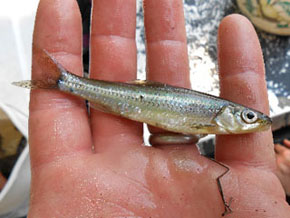Spottail Shiner
Notropis hudsonius
 Distribution: Widespread from the Mackenzie River to the St. Lawrence River and south along the Atlantic coast to Georgia and west to Kansas. In New Hampshire they are mainly found in the Connecticut and Merrimack Rivers and their tributaries along with a few lakes and ponds.
Distribution: Widespread from the Mackenzie River to the St. Lawrence River and south along the Atlantic coast to Georgia and west to Kansas. In New Hampshire they are mainly found in the Connecticut and Merrimack Rivers and their tributaries along with a few lakes and ponds.
Description: A medium-sized minnow from 2 to 5 inches in length. Streamlined body with silvery-bluish sides and a black spot at the base of the tail fin (spot sometimes not visible). Tail is deeply forked. Large loose scales come off easily. Anal and pelvic fins contain 8 rays. Sub-terminal mouth does not reach end of snout. The peritoneum (lining of the abdominal cavity) is silvery.
Species commonly confused with: Silvery Minnow, juvenile Fallfish
Habitat: Typically found in large lakes and rivers to small streams. They are often found in large schools and prefer sandy to silty areas with slower flows in rivers and streams.

Life History: Spawning occurs from June to July over sand and gravel substrate at the mouths of streams where large aggregations of ripe fish assemble. Not much else is known about the life history as it has not been thoroughly studied. Its tendency to school in large numbers likely makes the spottail shiner an important source of food for many predators in the Merrimack and Connecticut Rivers.
Origin: It is uncertain whether or not the spottail shiner is native to New Hampshire.
Conservation/Management: There are no specific conservation or management objectives for spottail shiner.
Fishing Tips: Spottail shiners can be fished for using very small hooks baited with a bit of worm. We have had reports from anglers jigging up spottail shiners through the ice while jigging for golden shiners on Connecticut River setbacks.



